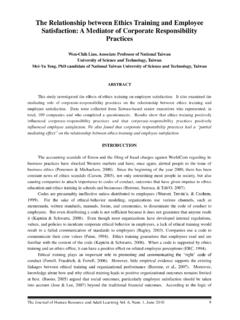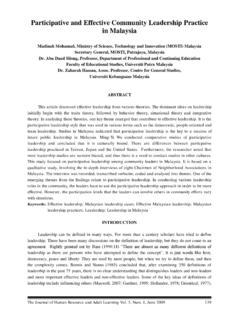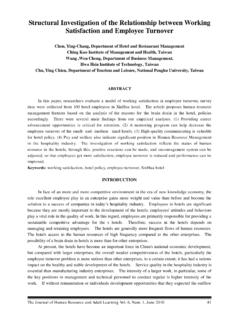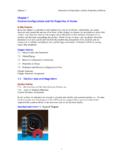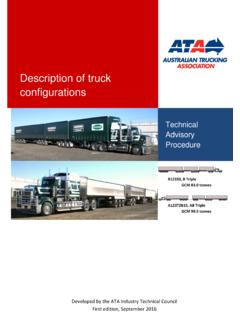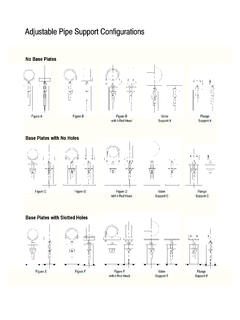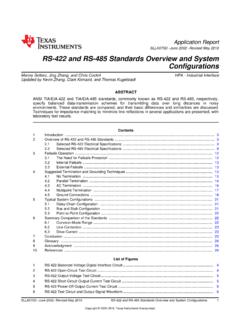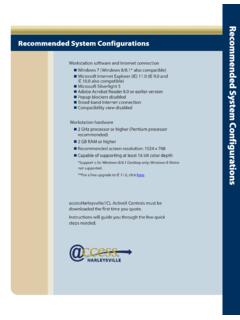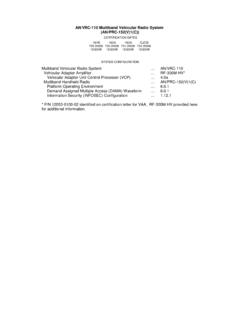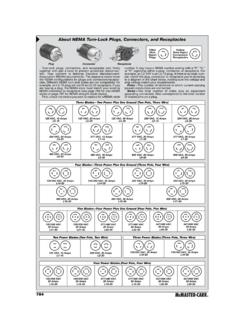Transcription of Matching Leadership Styles and Organization’s Structural ...
1 The Journal of Human Resource and Adult Learning * November 2006 39 Leadership Styles and organization Structural Configurations Dr. Sea-Shon Chen, Associate professor of Dahan Institute of Technology ABSTRACT This article focuses on discussing the existence of Leadership and organizations as well as the correlation between them. The core of Leadership contains power and traits; cognitive, affective, and technical competence overlay the Leadership core. The core and its overlaid competences express Leadership existence. Four Styles of Leadership existence are transactional, charismatic, transformational, and servant. Each Leadership style has its own specific competence. To express the existence of an organization is easier than that of Leadership because organizations are everywhere. Mintzberg suggested entrepreneurial, machine, diversified, professional, innovative, missionary, and political organizations which are introduced to identify different Structural configurations of an organization or organizational forms.
2 Finally, the strength of attribute to Leadership Styles correlating to each identical organization forms is evaluated to identify the differences of Leadership Styles and the organizational forms. INTRODUCTION Voluminous and various literatures have expressed the concepts of business organization and Leadership since the early twentieth century. A simple definition of Leadership may be used to develop a certain model of Leadership . Whereas a sentence or several lines may not sufficiently express the whole meaning of Leadership , it should be analyzed by and elaborated on its attributions and connotations. Thus, this paper will present a Leadership -competence model to state the existence and Styles of Leadership . Likewise, the definition of organization can be developed into different schools of organizational theories and designs. Therefore, the paper will introduce Mintzberg on management concerning the organization Structural configuration to describe seven organizations.
3 In author s opining, only few papers concern the correlation between Leadership Styles and the organization Structural configurations. Thus, the purpose of present paper is to classify traditional and contemporary Leadership according to their attributes and connotations in order to correlate Leadership style to Mintzberg s seven organizations. Because Leadership may decide effectiveness and growth or disruption of an organization , Leadership has received much attention (Johns, 1996, ). Many Leadership models, theories, and behaviors have been studied and introduced to the study of management and the organizational structure, so Leadership is introduced first. Leadership ATTRIBUTES AND CONNOTATIONS Leadership is perhaps the most widely presented and studied topic in the management and organization literature (Daft, 1998, p. 573). Because Leadership is a phenomenal existence, it is not an easy concept to define and is a difficult one to study and understand (Chen, 2003).
4 However, from leader s behavior and the atmosphere around a leader, we can see and feel the existence of Leadership . Leadership exists when the man influences people to obtain common recognition that helps reach goals. Scholars and researchers define that Leadership is the ability to influence members to voluntarily pursue organizational goals and that Leadership is the use of non-coercive and symbolic influence to direct and coordinate the activities of the members of an organized group toward the accomplishment of group objectives (Bateman and Snell, 2002, p. 380; Daft, 1998, p. 565; Dessler, 1998, p. 330; Jago, 1982; Kinicki and Williams, 2003, p. 448). To deeply understand Leadership , the contents and attributes of Leadership should be elaborated. Leadership includes two foundational or core components: power and personal traits (Dessler, p. 334; Kirkpatric and Locke, 1991; Ruth, 1996). Power is defined as the potential ability of a person to influence other persons to implement orders or to do something they would not otherwise have done.
5 Or, power is defined as the ability of a The Journal of Human Resource and Adult Learning * November 2006 40 person or group in an organization to influence other people to bring about desired outcomes. Although power is an abstract existence, , it cannot be seen, its effect can be felt. Power is an intangible force in organizations. But actually, in organization , power exists in a relationship between two or more people, and it can be exercised in either vertical or horizontal directions (Daft, 1998, ). Social scientists distinguished at least five sources of power: coercive, expert, legitimate, referent, and reward power (Daft and Marcic, 2004, pp. 414-5; French, Jr. and Raven, 1959: George and Jones, 1996, pp. 572-6; Kinicki and Williams, pp. 450-1). Psychologists and scholars define that a personality trait is any persisting characteristic of dimension of personality according to which individuals can be rated or measured (Coon, 1998, pp.)
6 519-27; Hanbury et al., 2004; Lefton and Valvatne, 1992, p. 419; Plotnik, 1996, p. 424). Most researchers agree on the five-factor model organizing all personality traits under five categories openness, conscientiousness, extroversion, agreeableness, and neuroticism those are used to describe differences in personality. Their initials make the acronym OCEAN. Each of the five personality traits actually represents a whole spectrum of behaviors (Coon, pp. 519-27; Plotnik, p. 425). Overlaying two core components power and traits, there are Leadership competences. Because Leadership can be learned, the Leadership competence may exist and be developed (Bass, 1990; Campbell and Dardis, 2004; Fairholm, 2004; Leek and Wang; 2004). To develop the right model of Leadership , we need to understand different types of organizations and competences (Higgs, 2003; Maccoby, 2004). The competences include cognitive, technical, and affective competence (Chen and Chang, 2001; Kinicki and Williams, pp.
7 449-53; Kouzes and Posner, 1987; Manske Jr., 1987; Rue and Byars, 2003, pp. 263-83), for example: Cognitive competence having multiple experiences, self-awareness, forward-looking, sharing information, listening to subordinates, life-long learning, intelligence, systematic thinking, envisioning, having business knowledge, social awareness, and creativeness. Affective competence self-confidence, willing to serve people, activeness, honesty and integrity, insisting on excellence, courage, compassion, decisiveness, passion, and willing to lead. Technical competence ability to execute, ability to organize team, self-management, relationship management, inspiring and motivating others, fostering communication, producing high-quality work, building group cohesiveness and pride, coaching to improve performance, and ability to design. Two foundational components, power and personal traits, and three competences, cognitive, technical, and affective competence, are illustrated on Figure 1.
8 That is the Leadership -competence model. Cognitive competence Technical Affective competence competence Figure 1. Connotations and attributes of Leadership -competence model Leadership Styles In the twentieth century, many Leadership theories, models, or Styles are presented. To find themes of these theories, models, and Styles , Leadership can be simplified and represented by two major branches. The first one, task Power Traits The Journal of Human Resource and Adult Learning * November 2006 41 performance Leadership style is that leaders effort to ensure the team of organization to reach its goals. The style focuses on following the rule, quality and accuracy, work speed, and quantity of output (Gardner and Daniel, 1998). This style is similar to job-centered, initiating structure, concerning for production, task-oriented, achievement-oriented, or directive style of the leader.
9 The second one, group maintenance Leadership style is that the leader takes action to ensure the satisfaction of organization members, to preserve the social stability of the organization , and to develop and maintain harmonious work relationships. The style concerns member s comfort and feelings, stress reduction, and appreciation of people (Gup, 1991; Yukl, 1971). The style is similar to employee-centered, consideration, concern for people, relationship oriented, or supportive and participative style of Leadership . For decades, Leadership concepts have evolved form the transactional approach to charismatic, transformational, and servant behaviors. These Leadership Styles in many literatures are named as transactional, charismatic, transformational, and servant Leadership style (Bateman and Snell, pp. 396-9; Daft and Marcic, pp. 429-37; DeCelles and Pfarrer, 2004; Kinicki and Williams, ; Krishnan, 2004; Stone et al.)
10 , 2004). The foundation of transactional Leadership is an exchanging process between leaders and followers. Transactional leaders focus on the interpersonal transactions between managers and employees; they motivates followers by exchanging rewards for high performance (Brain and Lewis, 2004; Chen, 2004; George and Jones, p. 387). The two characteristics of transactional Leadership are leaders using contingent rewards to motivate employees and leaders exerting corrective action only when subordinates fail to achieve performance goals (Kinicki and Williams, p. 468). Transactional leaders consider management as a series of transaction in which leaders use their legitimate, reward, and coercive powers to give commands and exchange rewards for services rendered (Bateman and Snell, p. 397; Wagner III and Hollenbeck, 1998, p. 222;). Transactional leaders focus on the present and are good at keeping organizations running smoothly and effectively.

